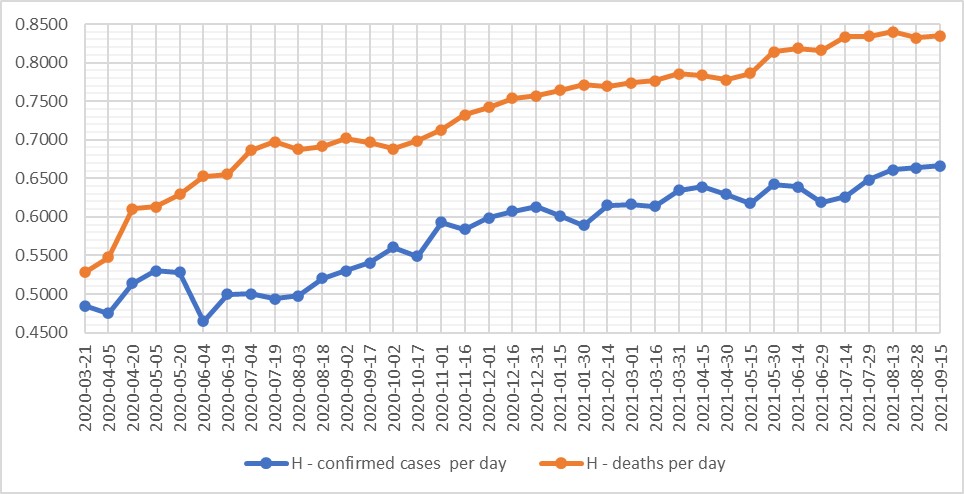Abstract
The objective of the present study was to show that the spread of the COVID-19 pandemic around the world shows complex system properties such as lognormal laws, temporal fluctuation scaling, and time correlation. First, the daily cumulative number of confirmed cases and deaths is distributed among countries as lognormals such that the time series exhibit a temporal fluctuation scaling. Second, the daily return time series of cases and deaths per day have associated Levy stable distributions and they have time correlation. The idea was to draw attention to the fact that the spread of the COVID-19 pandemic can be seen as a complex system, and, thus, contribute to the identification of the structural properties of this system, which is relevant as it is expected that future stochastic models describing the spread of the COVID-19 pandemic from a microscopic dynamics perspective should be able to explain the emergence of the structural properties identified here.
References
Abril F. S. & Quimbay C. J. (2021). Temporal fluctuation scaling in nonstationary time series using the path integral formalism. Physical Review E. 103: 042126. Doi: 10.1103/PhysRevE.103.042126
Álvarez, E., Brida, J. G., Linas, E. (2020). Comparisons of COVID-19 dynamics in the different countries of the World using time-series clustering. medRXiv preprint. Doi: 10.1101/2020.08.18.20177261
Anacleto, M. A., Brito, F. A., de Queiroz, A. R., Passos, E., Santos, J. R. L. (2020). Diffusive process under Lifshitz scaling and pandemics scenarios. Physica A: Statistical Mechanics and its Applications. 559: 125092. Doi: 10.1016/j.physa.2020.125092
António, N., Rita, P., Saraiva, P. (2021). COVID-19: Worldwide profiles during the first 250 days. Applied Sciences. 11: 3400. Doi: 10.3390/app11083400
Barro, R. J., Ursúa, J. F., Weng, J. (2020). The Coronavirus and the Great Influenza Pandemic: Lessons from the “Spanish Flu”for the Coronavirus’s potential effects on mortality and economic activity. Working Paper 26866. National Bureau of Economic Research. Doi 10.3386/w26866
Beare, B. K. & Toda, A. A. (2020). Diffusive process under Lifshitz scaling and pandemics scenarios. Physica D: Nonlinear Phenomena. 412: 132649. Doi: 10.1016/j.physd.2020.132649
Chen, C. C., Lee, Y. T., Chang, Y. F. (2008). A relationship between Hurst exponents of slip and waiting time data of earthquakes. Physica A: Statistical Mechanics and its Applications. 387(18): 4643-4648. Doi: 10.1016/j.physa.2007.08.063
Dimarco, G., Pareschi, L., Toscani, G., Zanella, M. (2020). Wealth distribution under the spread of infectious diseases. Physical Review E.102: 022303. Doi: 10.1103/PhysRevE. 102.022303
Dong, E., Du, H., Gardner, L. (2020). An interactive web-based dashboard to track COVID-19 in real time. Correspondence. 20 (5): 533-534. Doi: 10.1016/S1473-3099(20)30120-1
Drăgulescu, A. & Yakovenko, V. M. (2000). Statistical mechanics of money. The European Physical Journal B. 17: 723-729. Doi: 10.1007/s100510070114
Eisler, Z. & Kertész, J. (2006). Scaling theory of temporal correlations and size-dependent fluctuations in the traded value of stocks. Physical Review E. 73: 046109. Doi: 10.1103/PhysRevE.73.046109
Eisler, Z., Bartos, I., Kertész, J. (2007). Fluctuation scaling in complex systems: Taylor’s law and beyond. Advances in Physics. 57 (1): 89-142. Doi: 10.1080/00018730801893043
Feoli, A., Lannella, A. L., Benedetto, E. (2020). Spreading of COVID-19 in Italy as the spreading of a wave packet. The European Physical Journal Plus. 135: 644. Doi: 10.1140/epjp/s13360-020-00663-7
Fronczak, A. & Fronczak, P. (2010). Origins of Taylor’s power law for fluctuations scaling in complex systems. Physical Review E. 81: 066112. Doi: 10.1103/PhysRevE.81.066112
GitHub. (2021). COVID-19 Data. Accessed on: September 16, 2021. Available from: covid-19 data/public/data at master · owid/covid-19-data · GitHub.
Grau-Carles, P. (2000). Empirical evidence of long-range correlations in stock returns. Physica A: Statistical Mechanics and its Applications. 287 (3-4): 396-404. Doi: 10.1016/S0378-4371(00)00378-2
Hays, J. N. (2005). Epidemics and pandemics: their impact on human history. ABC-Clio, Inc. Santa Barbara, California, Pgs. 23, 41, 171, 193, 385.
Holovatch, Y., Kenna, R., Thurner S. (2017). Complex systems: physics beyond physics. European Journal of Physics. 38: 023002. Doi: 10.1088/1361-6404/aa5a87
Huremović, D. (2019). Brief History of Pandemics (Pandemics Throughout History). In: Huremović D. (eds) Psychiatry of Pandemics. Springer, Cham. Doi: 10.1007/978-3-030-15346-5_2
Limpert, E., Stahel, W. A., Abbt M. (2001). Log-normal distributions across the sciences: keys and klues. BioSciences. 51: 341-352. https://doi.org/10.1641/0006-3568(2001)051[0341:LNDATS]2.0.CO;2
Manttegna, R. N. & Stanley, H. E. (2000). An Introduction to Econophysics: Correlations and Complexity in Finance. Cambridge University Press, Cambridge. p. 48.
Melin, P. & Castillo, O. (2020). Analysis of spatial spread relationships of Coronavirus (COVID-19) pandemic in the world using self-organizing maps. Chaos, Solitons & Fractals. 138: 109917. Doi: 10.1016/j.chaos.2020.109917
Martín-Montoya, L. A., Aranda-Camacho, N. M., Quimbay, C. J. (2015). Long-range correlations and trends in Colombian seismic time series. Physica A: Statistical Mechanics and its Applications. 421: 124 133. Doi: 10.1016/j.physa.2014.10.073
Mitzenmacher, M. (2004). A brief history of generative models for power law and lognormal distributions. Internet Mathematics. 1: 226-251. Doi: 10.1080/15427951.2004.10129088
Quevedo, D. S. & Quimbay, C. J. (2020). Non-conservative kinetic model of wealth exchange with saving of production. The European Physical Journal B. 93: 186. Doi: 10.1140/epjb/e2020-10193-3
Sánchez-Granero, M. A., Trinidad-Segovia, J. E., García-Pérez, J. (2008). Some comments on Hurst exponent and the long-memory processes on capital markets. Physica A: Statistical Mechanics and its Applications. 387: 5543-5551. Doi: 10.1016/j.physa.2008.05.053
Stanley, H. E. (1971). Introduction to phase transitions and critical phenomena. Oxford University Press, London. p. 226.
Thurner S., Klimek, P., Hanel, R. (2020). A network-based explanation of why most COVID-19 infection curves are linear. Proceedings of the National Academic of Sciences of the United States of America. 117 (37): 22684-22689. Doi: 10.1073/pnas.2010398117
Trinidad-Segovia, J. E., Fernández-Martínez, M., Sánchez-Granero, M. A. (2012). A note on geometric method-based procedures to calculate the Hurst exponent. Physica A: Statistical Mechanics and its Applications. 391: 2209-2214. Doi: 10.1016/j.physa.2011.11.044
Varotsos. P. A., Sarlis, N. V., Skordas, E. S. (2002). Long-range correlations in the electric signals that precede rupture. Physical Review E. 66: 011902. Doi: 10.1103/PhysRevE.66.011902
Worldometers. (2021). “COVID-19 coronavirus pandemic”. Accessed on: September 16, 2021.Available from: https://www.worldometers.info/coronavirus

This work is licensed under a Creative Commons Attribution-NonCommercial-NoDerivatives 4.0 International License.
Copyright (c) 2021 Revista de la Academia Colombiana de Ciencias Exactas, Físicas y Naturales

